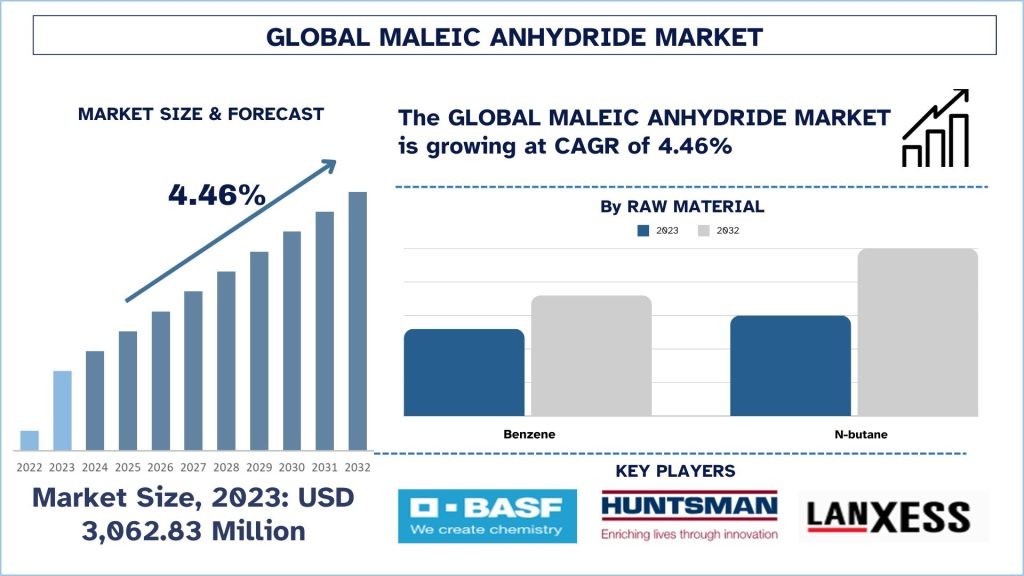Driving Sustainable Innovation: Global Maleic Anhydride Market Set to Reach, USD 4,512.28 Million by 2032, UnivDatos Market Insights
The global humectants market has witnessed remarkable growth in recent years, fueled by technological advancements and the need for high-performance components in sectors such as automotive, construction, and chemicals.
Adapting to Evolving Industry Demands
Industries around the world are looking for materials that offer high performance while being sustainable. This trend has been particularly prevalent in the automotive, construction, and chemical sectors, where maleic anhydride plays a crucial role in producing unsaturated polyester resins (UPR), 1,4-butanediol (BDO), and other derivatives. The construction industry is witnessing a growing trend of specifying long-lasting and environmentally friendly building materials. Maleic anhydride-based resins to form materials which are more durable and sustainable for use in any construction activities that are current in the market. The Polynt-Reichhold Group launched a sustainable production concept in 2020 that was meant to reduce the ecological footprint and the use of non-renewable resources in the production of maleic anhydride. This initiative coincides with current trends in the industry where most companies are embracing environmentally friendly manufacturing.
Maleic anhydride market is vital for the synthesis of several industrial chemicals such as BDO, tetrahydrofuran (THF), gamma-butyrolactone (GBL), and others. These chemicals are employed in different sectors including manufacturing of plastics and fibers, in producing of pharmaceuticals as well as in solvents. For instance, the demand for polyamide resins, which is fueled by the automotive industry, is pushing the maleic anhydride market forward.
Emphasis on Sustainability and Regulatory Compliance
As industries worldwide increasingly prioritize environmentally friendly practices, the maleic anhydride market has had to adapt to meet these evolving demands. The market for maleic anhydride is also growing at a steady pace and the issue of sustainability is now of great importance mostly due to the growing demand for bio-based production. Maleic anhydride is primarily prepared by the oxidation of benzene or n–butane which in turn comprises fossil fuels. Nevertheless, the recent developments have also better embraced the consumption of renewable feedstocks. For example, the current research focuses on bio-based succinic acid to replace conventional petrochemicals in the synthesis of maleic anhydride. This method not only eliminates reliance on a limited source of fuel energy but also helps to limit hazardous emissions of greenhouse gases. For instance, a partnership between BASF and Avantium to produce bio-based maleic anhydride. This collaboration aims to develop a sustainable production process using renewable feedstocks, thereby significantly reducing the carbon footprint ****ociated with maleic anhydride production.
Request Free Sample Pages with Graphs and Figures Here https://univdatos.com/get-a-fr....ee-sample-form-php/?
Technological Advancements and Investments
The maleic anhydride market is witnessing rapid technological advancements and significant investments from leading companies, driven by the need for innovative and efficient solutions. A notable trend in the industry is the adoption of advanced catalytic technologies and the use of bio-based feedstocks, reflecting a broader shift towards sustainability and improved production efficiency.
Bio-Based Feedstocks: The use of bio-based feedstocks is another notable trend reshaping the maleic anhydride market. Traditional production methods rely heavily on fossil fuels, which are ****ociated with high carbon emissions. In response to growing environmental concerns, companies are exploring renewable feedstocks to produce maleic anhydride in a more sustainable manner. Huntsman Corporation introduced a new series of catalysts that significantly improve the conversion rates of n-butane to maleic anhydride. These catalysts not only increase production efficiency but also reduce energy consumption and emissions. Huntsman's investment in research and development has resulted in catalysts that are more durable and effective, thereby optimizing the production process and minimizing downtime.
Conclusion
Transformation in the world market of maleic anhydride has come and will be progressively driven by more demand of lightweight plus strong and sustainable materials. The shifts in industries to eco-friendly processes also promote efficiency: this, in turn, calls upon the manufacturers to further step up their levels of innovation influenced by changes in technology regulations and sustainability trends. The introduction of green chemistry as well as sustainable production practices is going to change maleic anhydride market considerably with some benefits coming within the next few years; companies are striving to come up with state-of-the-art eco-sensitive products that would help them get a bigger portion of the market share.
Key Offerings of the Report
Market Size, Trends, & Forecast by Revenue | 2024−2032.
Market Dynamics – Leading Trends, Growth Drivers, Restraints, and Investment Opportunities
Market Segmentation – A detailed ****ysis by Raw Material and Application
Compe****ive Landscape – Top Key Vendors and Other Prominent Vendors
Contact Us:
UnivDatos Market Insights
Email - contact@univdatos.com
Contact Number - +1 9782263411
Website -www.univdatos.com
